Why recall isn’t a bad word: It restores Ola and Okinawa’s faith in electric automobiles.
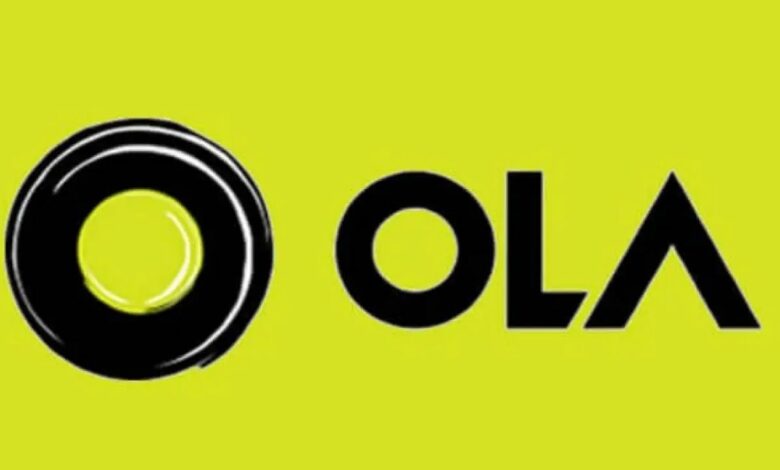
This is what PV Koteshwara Rao, an older man in Hyderabad, was doing on the Ola scooter his son had bought for almost 1 lakh and 40,000.
If you want to buy an Indian scooter, you’ll have to pay that much. So imagine how angry he was when his brand new, fully charged Ola scooter stopped for no reason, and he had to call a mini truck to bring it back home.
That wasn’t the first time his Ola scooter had made him look like the wrong person. During another day, Rao was pushing it down the road when he heard it go silent. To say it another way, someone came by and asked about “petrol.”

Even though this may have been dark humor, Rao didn’t enjoy it. Angry: Ola made him angry, frustrated, and angry.
A storyline about electric cars in India was not supposed to be this way. A quick search on Twitter shows that many people have had similar experiences to Rao’s. There is always bad news about EVs, and there was a loss of drive, Ola scooters going in reverse without warning, exploding batteries, and fires in the showrooms. People who are most likely to buy electric cars start to squirm.
Problems with EVs right now are simple. Two-wheelers, in particular, have a lot of problems. The buyer is afraid.
Businesses and the government need to do everything they can to earn back the public’s trust. Making hardware for cars is a hard job, but there is a first step they must take in their playbook, and they must first recall and fix the vehicles.
Even though Okinawa Autotech, India’s second-largest EV company by volume, is recalling some of its Ola scooters, the movie is only a good direction but not a good thing.
Ola, too, has recalled 1441 scooters after the fact. They say they did this to do “detailed diagnostics and health checks.”
There were a lot of talks that these were voluntary recalls. Still, the government, which is worried that its goal of getting India to use electric cars will be harmed if people are worried about the quality of the vehicles on the market, pushed for them to happen.
Recalling the good things about the past
In the beginning, recalls may not seem like a good thing for a brand. What about this? This is your chance to take a quick test! The company with the most recalls in India between 2012 and 2022 is the one that has the most.
Mercedes-Benz is the name of the company that makes the car.
The company is at the top of the list of luxury cars is simple. Recalls may sound bad for a brand at first, but in the long run, they make cars safer. A lot of memories come from brands that are known for being safe. People who work in the industry say Mercedes-Benz had 55 recalls, and the number of cars recalled was six times more than the company sold in 2021.
For the first time in Indian history, Honda Cars have recalled more than a million cars. This is 11 times more than the number of vehicles the company sold in FY22 and five times more than the number of cars they sold in FY19. It didn’t even matter that Toyota had the strictest quality and safety procedures, and Maruti Suzuki had more recalls than Toyota.
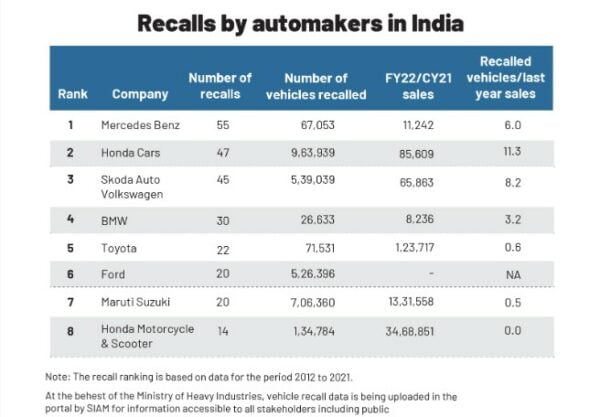
Those are the numbers on the side of the cars, like this one. At 14 and 6, Honda and Suzuki have the most recalls in a country where two-wheelers are very popular. There were three Royal Enfield recalls, but the largest was in 2021 when 2.3 lakh bikes were taken off the road. Data from the SIAM shows that Hero MotoCorp, Bajaj Auto, and TVS Motors have never been recalled, so they don’t have any.
Even though the data shows that more manufacturers need to own up to their mistakes and start recalls, the truth is that there is a culture of recalls only from well-known brands.
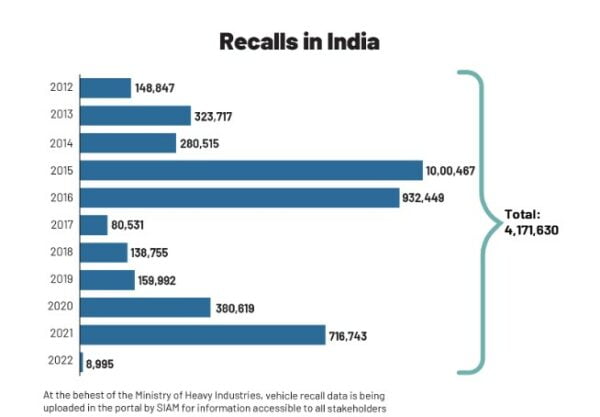
The law says this:
The government has made moves to make sure there is a process in place. In April 2021, the Ministry of Road Transport and Highways will put rules that require all vehicles to be recalled.
Recalls are based on two things, says Rishi Anand, partner at DSK Legal: (a) how many people have complained about a problem with the car, and (b) how many cars are sold each year with that same problem. The new law allows the government to tell a manufacturer to stop making cars if they have specific problems that could harm the environment, the people who drive them, or other people on the road, or if the government notices any other problems.
If complaints about a defective part in a particular model rise above a specific number, companies have to take back cars. For two-wheelers that sell between 3,001 and 60,000 units a year, if the number of complaints rises above 600 and 10% of sales rise above 3,000, the model will have to be recalled. If there are more than 6,300 complaints about two-wheelers that have sold more than 60,000 units, they will be placed. If there are more than 60,000 sales, they will be recalled.
Anand says that when the thresholds set by motor vehicle laws are breached, the law says that manufacturers must tell the Motor Vehicles Act’s designated officer and take preventive steps in the interest of the end consumer, even if the problem or defect isn’t big enough to warrant a recall.
The law in India says that companies like Honda two-wheelers can’t make voluntary recalls if the problems aren’t big enough for them to do so.
As long as the company is honest and is trying to deal with problems clearly, recalls are the only thing that makes sense. If companies are trying to hide something, that’s a different thing, says someone who works in the industry.
A company may try to get around the rules by grouping complaints into two or more different categories instead of putting them all together under one category. This way, they stay under the threshold that should prompt a recall. If the government asks for this data, companies don’t have to give it, which is very important.
There is a way for customers to complain about the Vahan site. If you want to complain about the safety of the roads, only 122 have been filed so far, and there have been 41 on environmental grounds.
There are a lot of complaints made to dealerships and call centers. When that doesn’t work, customers use social media to vent their anger. It might be a good idea for the government to tell people about the Vahan option in a big way.
In countries like the US, manufacturers can do voluntary recalls based on rules set by car companies or other groups. Countries in the EU have to follow stricter rules for memories, though.
How and why do people remember
Every car that leaves the factory has to go through a product-defect investigation (PDI) at the end of the assembly line. It has to pass this and get a tag that says “OK.” Recalls are about safety issues that aren’t found in this check or when cars come in for regular maintenance at the workshop.
Four everyday situations could lead to a recall, as shown below.
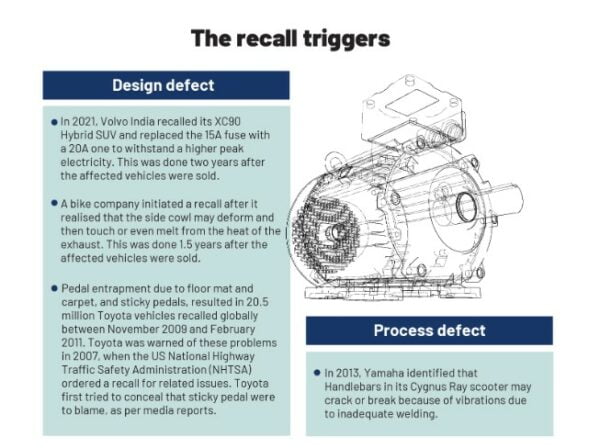
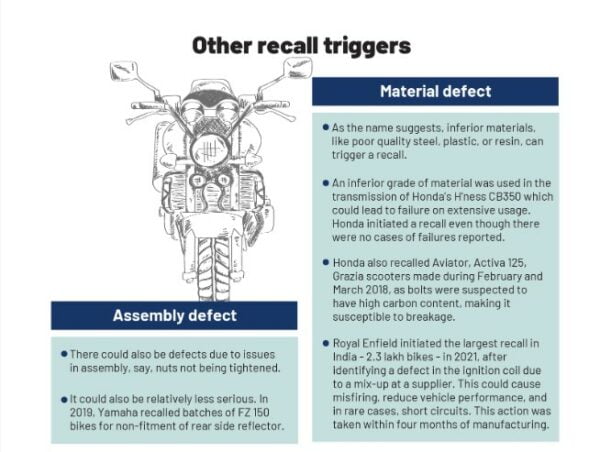
As well as the above triggers, there may be a need to highlight software defects under a separate head. Many electric cars can be updated over the air, but there may need to be more study at the government level about how to handle software-based vehicle recalls.
Recalls may sound bad for a brand at first, but in the long run, they make cars safer. A lot of memories come from brands that are known for being safe.
The world and India have had problems with electric cars.
General Motors (GM) will start recalling 68,000 Bolt EVs around the world in 2020. Afterward, it added every Bolt it had made since 2016 to the recall. By 2021, there will be 141,000 electric cars on the market. It also stopped making Bolt electric cars from August 2021 to April 2022. It took a lot of safety precautions and cut its operating range until the battery recalls were over.
This information came out only in August of 2021, when GM said that “in rare cases, the batteries supplied to GM may have two manufacturing defects, a torn anode tab and folded separator, in the same battery cell.” This increases the fire risk, and the manufacturing process didn’t account for this risk.
It’s not just Hyundai. Some of its fires were caused by the batteries in the cars. LG, the battery supplier, agreed to pay GM and Hyundai for most of the costs of recalling their electric vehicles, the Bolt and the Kona.
If design changes need to be made, they will be the most expensive and complicated. This is based on the Toyota recall in 2009-2011 and the battery problem with LG phones. Many people in the industry think that the issues with electric scooters in India might not be that hard to fix.
Okinawa said it would take back 3,215 Praise Pro scooters earlier this month. Companies usually give more information, like how long it will take to make and it’s a problem. In this case, both the reason for the recall and how it happened were unclear. The statement “to check for loose connectors or any damage” was very vague “In this case, I would say:
Many people in the business want more information. People in Okinawa first blamed customers for not charging their cars correctly, then they blamed a faulty socket, and now they’re calling back to check for loose connections and battery health. He thinks Okinawa doesn’t have a good team or system to diagnose and come up with long-term solutions.
It and Ola need to be more open.
By a long way, the Bhavish Agarwal-led company has the most people working for it. But there has been no communication from the company about what is causing the many problems its owners are having. Nearly a month after a fire ate an Ola scooter in Pune, the company hasn’t even released its first findings.
It hasn’t explained why its cars are stopping or shutting down even though they have enough charge or why reverse mode is being used when it doesn’t need to be.
Our questions will be answered in detail at a planned media event on April 23. Many other questions, too, will be answered, Ola told us. If the fire happens again, it says, “We’ll let you know more about it when we’re done with our investigation.” Our software, it says, has been updated to fix problems like a car shutting down and a reverse mode being activated by accident.”
Many of the complaints made by customers took a long time for Ola to respond to, so it took the cars to service stations and brought them back with new software. It’s not clear if this will be enough to solve the problem, but it could be. If these aren’t long-term fixes, the problem will worsen as the company keeps delivering scooters across the country, making the situation even worse.
Promise: Ola said it would be faster and longer battery life, and it also said it would be cheaper than Ather, which was already cheaper than Ola. And the weight of those problems is making the product not work as well as it should be. Our previous deep dive talked about how difficult it is to do all of these things because of the costs and time constraints. Maintaining silence doesn’t help anyone, least of all those who say they want to improve the Indian auto industry by making it better.



